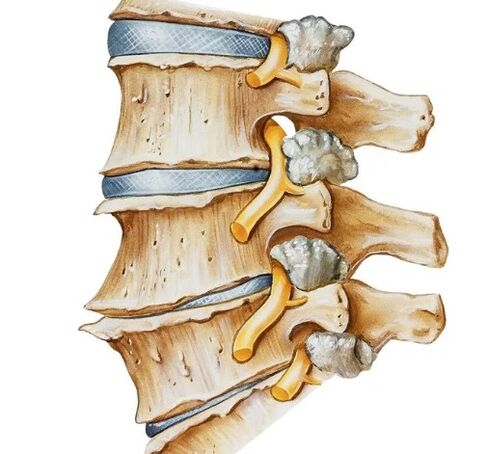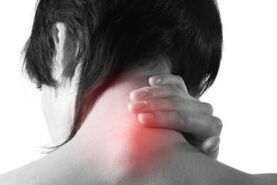Nodeosteochondrosis of symptoms and treatment of cervical spineThey will be different, depending on the type of deformation in the cervical vertebrae obtained in connection with a long physical, inflammatory or mental effect on them.

The disease is often chronic, manifested by many clinical symptoms caused by the tightening of nerve roots and blood vessels that come out of the vertebrae. Its compression is due to wear or deformation of intervertebral discs (reducing their height, loss of elasticity, deformation of the fibrous ring or its rupture). Cervical osteochondrosis is a common disease that occurs at any age after 20 years.
The reason for the pathology is in destructive changes in the spine. First of all, changes in intervertebral discs occur: its elasticity, strength and height decrease, its fibrous ring is deformed, protrusions (the early stage of intervertebral hernia) and hernias appear. All these changes cause bone growth in the vertebrae (osteophytes), lead to displacement and later - the loss of mobility of cervical vertebrae. Since the spine is a "case" flexible protector for the spinal cord, destructive changes in intervertebral discs, and loss of vertebral vertebrae flexibility are harmful to the nerve and vascular structures of the spinal cord. They are subject to squeeze, displacement, which interrupts brain circulation and innervation not only of the cervical and shoulder zone, but also from the internal organs, the lower extremities.
The older the patient, the more intervertebral discs were changed under the influence of age -related muscle weakening, long spinal loads, lesions, slowing physical activity, inadequate posture formation, stressful situations and increased tension in the neck, shoulder tape, inflammatory spinal diseases, etc.

Due to its anatomical structure, the cervical spine is more prone to pathology, since its vertebrae are more mobile and very well located in relation to each other. In addition, cervical vertebrae have weak muscle protection. Most of the time, degenerative changes develop in the intervertebral discs of cervical vertebrae 5. 6 more mobile.
What are the symptoms of cervical osteochondrosis
Diversity and inconsistency of symptoms
Osteochondrosis of cervical spine symptoms and treatmentIt should be considered comprehensively and in conjunction with the type and severity of intervertebral disc degeneration. Signs of cervical osteochondrosis are diverse and contradictory, as they depend on the location and strength of the manifestation of the intervertebral disc deformation process, the peculiarities of compression or tightening of nerve roots and blood vessels, as well as the location of the muscles and organs.
Therefore, patients' complaints are often not directed to a neurologist, but to other experts: a cardiologist, therapist, otolaryngologist, an optometrist, a rheumatologist, etc. For example, dizziness complaints, shoulder joint pain, or noise in the ears, darkness in the eyes, patients do not associate shrugs or noise in the ears, the eyes, do not associate hiking skates on their shoulders. At the same time, a neuropathologist can diagnose cervical osteochondrosis based on the results of a brain magnetic resonance imaging and spine, brain brain ultrasound, ECG, etc.
Three sets of impaired function signals of the nervous system
Experienced experts know thirty different options a combination of cervical osteochondrosis symptoms. It will not be possible to describe all signs of manifestations of this common disease, so let's look atthree complexesThe main symptoms that characterize certain impaired functions of the central nervous system.
The first basic symptom complex applies to impaired functions of the peripheral section of the nervous system. This department is represented by nerves and other elements that are leaving the brain and spinal cord and is divided into somatic and autonomic systems.
In short, the first symptom complex of cervical osteochondrosis is presented in the form of various pain location. This does not mean that signs are only painful, pains are often combined with other impaired body functions. But mainly - they are constantly or periodically in the neck, whose appearance the patient connects with hypothermia, prolonged stress or an uncomfortable pose, lifting weights, a sharp turn of the head.
The pains are sore, shooting or similar to a shock. Its location depends on the tension of certain muscles associated with specific roots of the nerves, which are squeezed by the vertebrae. Therefore, pain can spread around the neck, nape, shoulder, one or both hands, radiate to the chest - to the heart area, liver. In addition, there are complaints of crispness or cracks in the vertebrae of the cervical region when the head moves, as well as the rigidity of the rotational movements of the head.
At the acute beginning of the disease, pain and spasm of the neck muscles force the patient to be in a pose with his head inclined and walked away. Burning pains may appear between shoulder blats if cervical vegetative formations are compressed and their blood supply is disturbed. Such pains usually increase with physical and emotional stress.
Often, there is swelling, pallor and cooling of the hands, numbness, rapid heartbeat, heart pain, narrowing or expansion of students, etc. Due to impaired shoulder innervation and spatular region, symptoms of dystrophic change may occur in the shoulder joint. Patients complain of pain, the inability to lift and bring their hand to the side, the stiffness of the shoulder joint.
The second complex of symptoms of cervical osteochondrosis occurs due to the impaired function of the spinal cord and is manifested by engine disorders.
The disorders of spinal cord functions occur due to its compression as a result of the loss of a disk spray nucleus or lesion with discs and solid growth (osteophytes). Depending on the mechanism of exposure to the spinal cord, the following motor disorders complex is observed: the rigidity of the occipital and cervical muscles, the weakness of the arms and legs, with an increased tone of the leg muscles and the reduced tone and weight loss; Loss of temperature and pain sensitivity; Strong leg strong, impaired coordination.
The third set of symptoms characterizes blood supply disorders in brain vessels and cranial nerve pathology that occur due to deformations in cervical vertebrae. The symptoms of vascular pathology are manifested.
Characteristic symptoms of vascular disorders:
- Neurotic conditions (irritability, longing, anxiety, fatigue, sleep disorders);
- fainting; headache and dizziness; nausea and vomiting;
- Noise and touch the ears, hearing loss;
- visual disorders (darkness in the eyes, fog, trembling points, visual impairment);
- Glorious mining syndrome (sore throat, a feeling of foreign object, dryness, difficulty swallowing).
The symptoms of cervical osteochondrosis are not unequivocal and should be considered in the complex and depending on pathological processes in the spine.
Only a qualified specialist can deal with the clinical manifestations of this disease, make the correct diagnosis and prescribe the correct treatment of causes of detected disorders.
How to treat this disease
Symptom osteochondrosis and treatment of cervical spine depend on the condition of the patient, the severity of the disease, the nature of damage to cervical vertebrae.
In the acute period, hospitalization and drug treatment may be required. They usually use painkillers, muscle blockade of novocaine, muscle relaxants that relieve muscle spasm; CondoProtectors for cartilage fabric nutrition; Sedative drugs that soothe the nervous system, vitamins B, increasing neuromuscular conductivity. The treatment of cervical spine osteochondrosis is always long and should be complex.
During periods of remission, when acute symptoms are absent, physiotherapy methods (electrophoresis, ultrasound, etc. ), therapeutic physical education, massage and non -traditional procedures, for example, acupuncture, are necessarily prescribed.

Many conservative methods of osteochondrosis treatment are known, which can interrupt the progression of the disease. However, each patient needs an individual treatment course taking into account the stage of the disease, the characteristics of the body, gender and age. The objective of the treatment of cervical osteochondrosis is:
- Elimination of pain and edema at the site of inflammation.
- Relaxation of tense neck muscles.
- The release of arrested nerve roots.
- Increased blood circulation.
- Activation of metabolism.
- Improving the power of intervertebral discs.
Directed complex treatment may prevent protros and intervertebral hernias.
So that symptoms and treatment osteochondrosis and treatment are not launched, and serious complications of the disease should begin to begin timely treatment.

























